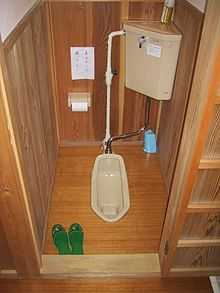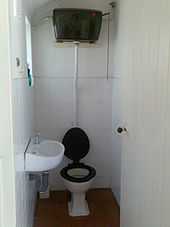Toilet (room)
A toilet room is a room containing a toilet and sometimes a sink (washbasin).
Alternative names
A toilet room, often shortened to just toilet, may also be called a lavatory, or WC, short for "water closet".
In places such as North America where the norm in residences is for there not to be a separate room, the toilet is almost always in the bathroom and a separate room may be referred to euphemistically as a bathroom or "restroom", washroom,[1] "half bath" or "powder room". This is often downstairs, with a sink, primarily for the use of guests.[2]
Informal words for the toilet, such as "loo", "Room 100", "lav" (lavatory), "clo" (closet), "john", "head" (from boating), and "the necessary" may also be used to refer to the room.
History
Before effective flush toilets or composting toilets were available the place containing the toilet often consisted of a small external outhouse containing a pit toilet, pail closet or similar. Indoor toilets were first provided in houses for the well-to-do and gradually spread to the lower classes; for example in London in the 1890s, separate building regulations for working-class housing did not require indoor toilets, and after 1900 some small working-class houses were still being built with outdoor toilets; some houses were built with an upstairs toilet and an outside one, presumably for servant use.[3] In Leeds and Halifax, there was a transitional stage where toilet rooms were placed inside the house but accessible only from the outside.[4] Indoor washing facilities were separately introduced, beginning with a sink near the bedrooms, the original meaning of "lavatory"; working-class residences often had only a collapsible tub for bathing, and in houses with both a toilet and a bathroom, they were placed side by side in the back extension above the kitchen and scullery for plumbing reasons. Bathrooms became standard in new housing later than did toilet rooms, and only became normal in working-class housing in the UK after World War I.[5][6] After 1919, all new housing in the suburbs of London had an inside toilet; where it was placed in the bathroom, the reason was cost savings.[7] Hermann Muthesius had noted in 1904 that "a lavatory is practically never found in an English bathroom; indeed it is considered downright inadmissible to have one there", despite the impression created by plumbers' catalogues.[8] Separate toilet compartments remain common in British homes,[6] and are still a builder's option when there is sufficient space even in places where the norm is for the toilet to be in the bathroom.[9] In some countries, such as France and Japan, a separate toilet room remains the norm for reasons of hygiene and privacy.[2][10][11][12]
Modern toilet rooms often also contain a sink. In Japan, special toilet slippers are traditionally left for use in the toilet room,[12][13][14] and the toilet may have a built-in sink whose waste water is used for the next flush, so that the user can wash immediately.[15] France is unusual in Europe in separating bathing and toilet rooms, although families say it saves time when several people need to use the facilities; however, in France, there is often no sink in that room.[16]
Gallery
-

A pit toilet, or 'dunny' in New South Wales, Australia
-
A modern toilet room in an Australian home
-

A toilet room in a Japanese temple hotel, with squat toilet and toilet slippers
References
- ↑ Zoltan Kovecses, American English: An Introduction, Peterborough, Ontario: Broadview, 2000, ISBN 9781551112299, p. 253. All the common words for toilet were originally euphemisms, including "toilet": Lyle Campbell, Historical Linguistics: An Introduction, 2nd ed. Cambridge, Massachusetts: MIT, 2006, ISBN 9780262532679, p. 263.
- ↑ 2.0 2.1 John Thompson and Bethanne Patrick, An Uncommon History of Common Things, Washington, DC: National Geographic, 2009, ISBN 9781426204203, p. 140.
- ↑ Stefan Muthesius, The English Terraced House, New Haven/London: Yale University, 1982, ISBN 9780300028713, p. 60.
- ↑ Muthesius, Plates 86, 87, p. 121.
- ↑ Muthesius, pp. 61–62, 100, 137.
- ↑ 6.0 6.1 William E. Schmidt, "English Bathrooms: Out of the Closet", The New York Times, January 3, 1992.
- ↑ Alan A. Jackson, Semi-Detached London: Suburban Development, Life and Transport, 1900–39, London: Allen & Unwin, 1973, ISBN 9780049020030, p. 145.
- ↑ Hermann Muthesius, Das englische Haus: Entwicklung, Bedingungen, Anlage, Aufbau, Einrichtung und Innenraum, 3 vols., Berlin: Wasmuth, 1904–05, OCLC 3437464 (German), tr. Janet Seligman, The English House, London: Granada, 1979, ISBN 9780258971017, volume 2, p. 236; quoted in Helen C. Long, The Edwardian House: The Middle-Class Home in Britain, 1880-1914, Studies in design and material culture, Manchester: Manchester University, 1993, ISBN 9780719037283, p. 97.
- ↑ Henry Harrison, Houses: The Illustrated Guide to Construction, Design, and Systems, 3rd ed. Chicago: Real Estate Education Co., Residential Sales Council, 1998, ISBN 9780793129676, pp. 64–65.
- ↑ Sally Adamson Taylor, Culture Shock!: France, 2nd ed. Portland, Oregon: Graphic Arts Center, 2003, OCLC 30753428, p. 199.
- ↑ Alan Goldman, Doing Business With the Japanese: A Guide to Successful Communication, Management and Diplomacy, SUNY series in speech communication, Albany, New York: State University of New York Press, 1994, ISBN 9780791419465, p. 73.
- ↑ 12.0 12.1 "toilets", Encyclopedia of Contemporary Japanese Culture, ed. Sandra Buckley, London/New York: Routledge, 2002, ISBN 9780415143448.
- ↑ Jennifer Phillips, ed. Suzanne McQuade, "Personal Hygiene", In the Know in Japan: The Indispensable Cross-cultural Guide to Working and Living in Japan, New York: Terra Cognita/Living Language, 2003, ISBN 9780609611142.
- ↑ Andrew Horvat, Japanese Beyond Words: How to Walk and Talk Like a Native Speaker, Berkeley, California: Stone Bridge, 2000, ISBN 9781880656426, pp. 28–29.
- ↑ Harvey Luskin Molotch, Where Stuff Comes from: How Toasters, Toilets, Cars, Computers, and Many Other Things Come to Be As They Are, New York: Routledge, 2003, ISBN 9780415944007, pp. 101–02.
- ↑ Jean-Michel Léger, Derniers domiciles connus: enquête sur les nouveaux logements, 1970–1990, Ministère de l'équipement, du logement, des transports et de l'espace, Paris: Créaphis, 1990, ISBN 9782907150187, p. 129 (French)
| ||||||||||||||||||||||||||||||
